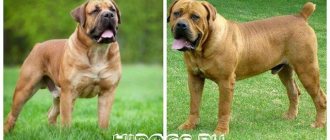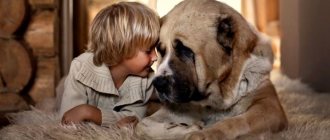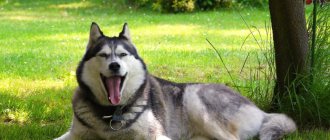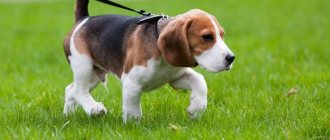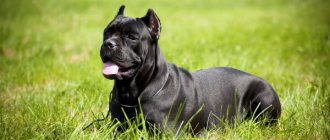Breed characteristics and character
The South African Boerboel is one of the breeds that is not recognized by the largest international canine community, the FCI. In addition to this, some breeders put stamps on the dog such as “tailless mastiff” or “half-breed”.
In fact, Boerboels have mastiffs as relatives, but they certainly cannot be called half-breeds or mestizos. This is a separate breed, the roots of which are directed to the distant past.
Battles involving them are described in historical references dating back hundreds of years. The dogs, described as similar to Boerboels, were participants in gladiator fights in Britain. Towards the middle of the 16th century, animals began to spread across the lands of the Republic of South Africa.
People who settled on the Cape of Good Hope took many dogs as guards, so the island sheltered various guard breeds from Europe. It is difficult to say with certainty who exactly is the progenitor of modern Boerboels. In addition, dogs performed the functions of farmers - tending herds and flocks.
By the end of the twentieth century the Boerboel breed had completely disappeared from the face of the earth - the process of urbanization and the no longer need for protection and conservation led to this. However, dog handlers realized it in time and quickly began to restore the breed. There were breeders, kennel owners and several African enthusiasts who were able to achieve the breeding and distribution of dogs throughout the globe.
The dogs quickly began to gain popularity due to their independent and balanced character. But at the same time, it is important to remember the ancient instincts of a protector. A dog can easily attack a person and even bite someone who encroaches on someone else’s territory.
It is important that the dog is socialized from puppyhood and raised among people. He is easy to train and train. However, your dog will need a leash and a muzzle when walking.
Breed standard
Males grow up to 66 cm, females - up to 61 cm. The head is considered the hallmark of the breed - it has the shape of a rectangle, developed muscles, including chewing muscles. The stop is smooth, slightly inclined, the furrow between the eyes is not too deep.
The wide muzzle tapers towards the nose. The nasal lobe has widely spaced nostrils. The powerful and deep jaws are equipped with a row of white, strong teeth with a regular, scissor bite. At the same time, underbites are unacceptable. The upper lip slightly covers the lower one.
The dog looks at the world with round eyes of medium size, straight and wide. Any shade of brown in color is acceptable, but the darker the eyeballs, the better. The dog has a smart look. Triangular ears are located close to the head, have a wide set, and their edges are rounded.
The powerful neck is equipped with a well-defined scruff, smoothly blending into the withers. The body visually resembles a rectangle. The chest is wide and deep, has powerful muscles. The lower back is straight, the groins are moderately tucked. The animal's tail is thick and set high, and may be densely covered with hair.
This part of the body of dogs is usually docked at the level of 3-4 vertebrae. But undocked variations are also possible. The limbs must be strong and properly formed, have strong bones and pronounced muscles.
If you look at the dog from the front, the paws are vertical, parallel to each other. They are large and strong at the ends, rounded, with curved toes and thick paw pads. When walking and running, the dog is characterized by powerful, purposeful movements.
Boerboel resting in the meadow in summer after an intense run
The Boerboel is equipped with thick, but not tight-fitting skin; there may be a slight sagging on the neck. The coat has black pigmentation in the eye area, nose, paw pads, nails and genital area. The short coat is thick and smooth to the touch, shiny. Possible colors include solid fawn or red, as well as brindle.
Sometimes white spots on the chest and legs are acceptable, but not above the wrists. Other colors are not acceptable. However, the black Boerboel .
It was popular until the mid-80s, when breed standards excluded it from the herd. The black gene is very strong and dominant, but at the same time it is quite easy to remove - it is enough to exclude this color from breeding, and it will be eliminated in one generation.
Today, the popularity of anthracite and coal shades is returning. Perhaps soon dog handlers will reconsider their attitude to color and include it in the breed standard.
Care and maintenance
The Boerboel in the photo looks like a large dog with powerfully developed muscles and strong bones. This is achieved through proper nutrition and proper care of the dog. The breed is distinguished by the fact that it easily adapts to various conditions.
Accordingly, the dog can live both on a country plot in a cottage and in a city apartment as a full member of the family. In addition, the pet can live outside if it has a sufficiently spacious and warm enclosure.
If the Boerboel is kept in an apartment, then it needs to be walked at least twice a day. The dog is not a breed that requires intense physical activity and long walks. But fresh air will be good for her. In the apartment, the dog should have its own furnished place with bedding. It is better if it is a corner without drafts.
The dog's short, dense coat does not require complex combing procedures. It is enough to wipe it with a mitten from time to time and wash its paws and belly in slushy weather. These dogs do not require bathing, so you can get by with bathing procedures once every six months.
Your teeth will require the most meticulous care - it is important to brush them several times a week. It is worth examining the dog’s ears and wiping the eyes with a swab dipped in clean water at room temperature. Sometimes it is worth trimming the claws with special devices. An alternative option is to take your dog to the groomer from time to time.
Weight:
- from 60 to 90 kg
Lifespan: 12 – 15 years
Apartment living is not recommended, suitable only for experienced owners
This is a harmonious and well-balanced dog, with clearly defined muscles and powerful, strong bones. Thanks to the elastic ligaments of the limbs, South African Boerboels move almost silently.
The Boerboel's coat is smooth and short. Color can range from cream, light yellow to dark red, including all brindle and spotted colors. There may be a mask on the face, and the ears are darkened.
Boerboel character
Attention! Owners should always keep Boerboels under control! They can seriously injure or even kill another dog without much effort. The South African Boerboel is a formidable and devoted guard and watchman. He will always bark when someone unfamiliar approaches, but he quickly learns who is a friend and will calmly let someone introduced to him into the house.
The South African Boerboel should only be kept behind a secure fence, because... these dogs tend to expand the boundaries of the territory they protect as soon as they leave the confines of their home.
Security and guard instincts do not prevent the Boerboel from being an affectionate family pet. The South African Boerboel loves spending time with his family. Despite their aggression towards strangers, these dogs are very friendly with all family members.
Most representatives of the breed get along well with familiar children. The South African Boerboel is also exceptionally gentle with small children. However, remember that young children should never be left unattended with any dog. You need to be especially careful with those dogs that have no experience interacting with children.
With proper upbringing, the Boerboel gets along well with other animals. Good socialization is the basis for the correct behavior of the South African Boerboel. It is important to teach him to distinguish between intruders and harmless strangers.
Boerboels have a stable psyche, are very smart and have a good memory, and learn quickly. They are very active and mobile and require daily exercise (for example, 5 km runs).
Care and maintenance of the Boerboel
The South African Boerboel's coat is quite easy to care for. The dog needs to be brushed once or twice a week. It is advisable to brush your dog's teeth regularly. You need to bathe as necessary, using a special shampoo. Nails should be trimmed periodically. To do this, use a special tool for trimming dog nails.
The South African Boerboel does not require any special exercise to exercise. They are able to exercise independently, periodically patrolling the fenced area. They are wonderful walking or jogging companions and love to go on family walks. Boerboels love to have objects thrown at them and can spend a lot of time chasing a ball or stick.
As South African Boerboels age, they become less active. If your Boerboel begins to move very little and gain weight, the owner needs to provide him with regular exercise that will help him live a healthy and happy life.
Feeding
The number of feedings of a puppy during the day depends on its age: 1-2 month old puppies are usually recommended to feed 6 times a day, 2-4 month old puppies - 5 times a day, 4-5 month old puppies - 4 times a day, 5-6 - menstruation – 3 times a day. A six-month-old puppy should be gradually accustomed to the diet of an adult dog, and at the age of 8-9 months the pet can switch to the normal diet of adult Boerboels, which includes 2 feedings a day: morning and evening.
Feedings should be done at the same time every day. Both puppies and adult dogs should not be given food at night.
Price
Responsible breeders identify puppies with genetic abnormalities, weed them out, and the remaining ones are raised and vaccinated correctly. The price of a puppy ranges from 20,000 to 30,000 rubles and it is better to overpay for a healthy puppy with a stable psyche.
Nutrition
The Boerboel dog is a large breed, so nutrition will be provided based on the needs and size of the dog. For example, you will definitely need a stand under a bowl of food so that the dog does not lower its head low to the floor, thereby bending the cervical vertebrae.
It is better if the stand is long and can accommodate several bowls at once, including water and dry food if the animal is mixed-fed. There is still no established opinion among breeders as to which type of feeding is best.
Each has its own advantages and disadvantages. For example, natural food is natural, a natural source of vitamins. Dry factory food is a balanced product, enriched with microelements in the proportions required for the breed. There is also a mixed type of feeding, but it is used much less frequently, and also has limitations: it cannot be used if the dog is prone to allergies.
Boerboel puppies receive food 5 times a day for up to 4 months. Up to 5-6 months, feeding occurs 4 times a day, then up to 9 months - three times a day, and after that - twice a day. In this case, the volume of portions increases as the number of feedings decreases. An adult Boerboel can eat up to 1.5 liters of food at a time.
If we are talking about natural food, then the basis of the diet, as is the case with other breeds, is made up of protein-containing products - meat and fish. All this should not be fatty, and it is better to exclude pork from the diet altogether - its fat is poorly digested by a dog’s stomach.
By-products are also suitable, and sea or ocean fish is preferable. It is important that the meat (beef, lamb, veal, horse meat) is raw. You can cut it into pieces. You can’t give minced meat - it lingers in the dog’s gastrointestinal tract and comes out not completely digested. If your four-legged friend refuses raw food, you can scald it with boiling water.
You can give eggs a couple of times a week, preferably raw yolks. It is not necessary to feed protein, as it is poorly digestible. For dairy products, the best options would be cottage cheese, low-fat yogurt and kefir. Moreover, you can prepare cottage cheese yourself. Bones are prohibited and are suitable only as an auxiliary material for teething. Cereals are not recommended for this breed.
The Boerboel has a strong build
At least, they definitely won’t become the main food. From time to time you can give finely chopped vegetables such as carrots, cabbage, pumpkin, and zucchini. You can put a spoonful of sour cream or a drop of vegetable oil in them. When training, cheese and dry fruits are suitable as rewards. Don't forget about vitamins. They must be given in addition to the main portion.
Boerboel Breeders Association + Official breed standard.
SABT - South African Boerboel Breeders' Association
HBSA - Historic Boerboel Breeders' Association of South Africa
KUSA - Kennel Union of South Africa
EBASSA - Elite Boerboel Breeders Association
SABT is the first Association of Boerboel Breeders and Fanciers to own its own and began to register the first dogs in South Africa. Boerboels were literally collected one at a time from all corners of South Africa, because... the breed was already on the verge of extinction at that moment. What they could find was where registration and actual breeding began. Spotted and black Boerboels have always lived there, but just like in the rest of the animal world, their habitat for different colors was very scattered. Since they are farm dogs, they lived on remote farms, sometimes thousands of kilometers apart. Many South Africans have never been to such remote areas in their entire lives. There were only a few red-colored Boerboels in those days. During their travels, they were unable to find dogs of spotted and black colors, and for this reason they decided not to include these colors in the standard when forming the SABT. Later, this decision was revised and the standard was changed, because puppies of similar colors periodically appear in litters, even from two red parents. This suggests that the genes of these dogs still carry the ability to pass on these colors by inheritance.
HBSA - Historical Boerboel Association, was formed a few years after SABT, where the “mistake” with colors was corrected. Moreover, it was created by the same person who founded SABT.
EBASSA is the youngest association, but very worthy. The idea of its creation arose because at that moment many different types of dogs began to appear (not by color, but by type!!)), so the idea came to create an organization that would conduct a more stringent selection for breeding. Not every Boerboel is allowed to be bred at EBBASSA. They have certain requirements for the dogs before you are given "for breeding" status. This is reflected in the name of the association - Elite...
In South Africa, another Boerboel Breeders Association was formed - BI (Boerboel International), which also registers Boerboels of all colors.
Today, all 4 Associations of South Africa officially recognize spotted Boerboels, 3 of them recognize black Boerboels, such puppies will be happy to be registered there, because The breeders themselves show great interest in them. Any of these associations accepts dogs from the other association for registration. Those. if you have a pedigree for a puppy, issued, for example, by HBSA, this dog or puppies from such a dog can be easily registered with any of these Associations. They acknowledge each other's registration.
KUSA Kennel Union of South Africa (FCI). The first Boerboels were registered with KUSA in 2006. ANY Boerboels with documents from ANY of the above Associations are accepted for registration. Until recently, KUSA registered dogs of different colors, including black (although in the documents this color was indicated as ultra-brindle, i.e. black and brindle), as well as Irish color. Moreover, these dogs were successfully exhibited and took part in KUSA (FCI) shows, and even won titles.
Information 2009.
Possible diseases
The African Boerboel is considered a dog with strong immunity and good health. There are practically no closely related matings in his blood, so there are a minimum of genetic deviations. However, there are some diseases that are specific to this breed.
First of all, we are talking about dysplasia of the joints - elbow and hip. This disease occurs in every second large dog. Unfortunately, large breeds are not insured against it. Even with high-quality prevention, sometimes it is not possible to avoid joint problems.
African Boerboel
In addition, as they get older, many dogs suffer from degenerative myelopathy, which can be diagnosed by the animal’s gait: the dog’s back end falls in different directions, and the pelvis begins to wobble.
Another disease that affects Boerboel bitches is vaginal hyperplasia. Because of this, dogs are not allowed to be bred. Osteomyelitis, which occurs due to staphylococcal and fungal infections, affects Boerboel puppies . And hepatopathy can affect both young and adult individuals. It manifests itself in the form of liver failure and a decrease in the functions of this organ.
Dog kennel Quiet Harbor of Hope. Boerboel
| Description: | Boerboel nursery "Quiet Harbor of Hope" is one of the leading nurseries in Russia. The purpose of which is to breed, preserve and popularize the breed in Russia and abroad. The Boerboel is a companion and an excellent guard, a reliable friend and protector for you and your loved ones, friendly to children, and gets along well with other animals. The result of our work is healthy, strong, athletic and pedigree dogs. Over the years, dogs of our breeding have confidently withstood competition and won at the most prestigious exhibitions in Russia and abroad. |
| Contacts: | +7-985-130-69-29 |
